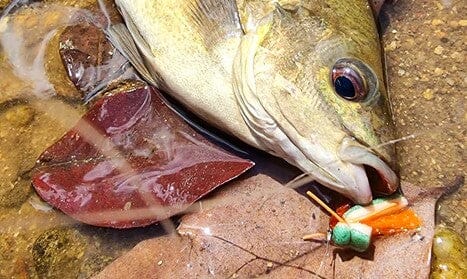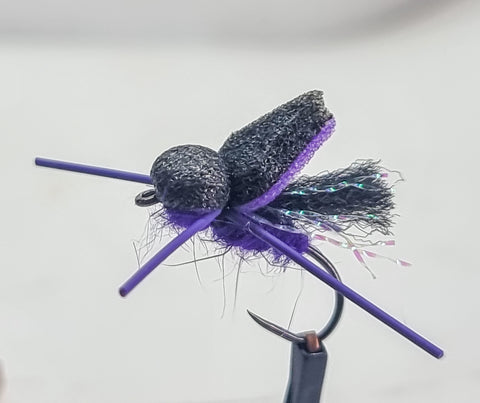
Dry Fly Fishing in Tropical North Queensland
A Guest blog by Upavon Consultant Davie Little.
Sooty's
Being so close to the pristine sand and coral flats of the great barrier reef as well as the wetlands and estuaries that so many iconic sports fish call home, the Sooty Grunter, or Sooty as the locals call them, is an often overlooked freshwater Fish species in Northern Australia. Nonetheless, for me, these hardy little brawlers tick all the right boxes. Sooty's are accessible, eat flies, fight well (sometimes dirty), you can sight fish for them in crystal clear water, and most importantly (in my eyes), they love a well-presented dry fly. I will be honest though. Over the years, I have had so much success fishing streamer patterns and other wet flies for Sooty's that it took me until a couple of years ago to finally see the light.

The Creek
It was a beautiful day on a creek. The water level was still dropping from the recent wet season when I was lucky enough to witness fish sipping off a bubble trail, just like you would expect a brown trout in much colder waters. That day, I fished with a small gurgler as it was all I had in my fly box, but since then I have not looked back, always taking the opportunity to fish dries when it comes. Working on variations of traditional patterns to fit my needs.
Dry fly fishing for Sooty's
Dry fly fishing for Sooty's might not fit the traditionalist's view. However, it is my favourite way of catching them now. Fur and feathers often will not stand up to the rigours of the aggressive takes and hard-fighting Sooty's. And this is where a good foam fly comes in. Flies tied with foam will float all day (if tied well) and offer a more meaty profile than, say, a Royal Wulff or a Stimulator, which is important when it is equally likely that a hapless bird spider, Christmas beetle or small lizard will end up in their line of sight, and offer a tasty snack.

Fishing at the end of the dry season
Most recently, I was lucky enough to spend a couple of days on a remote cattle station camped by one of my favourite rivers. I drove out with excitement for things to come, but my heart sank when I saw just how low the water was. It has been another long dry season here in North Queensland, and somehow, even now, as we listen to the first of the year’s thunderstorms, it seems even drier than usual.
There was a lot of sand between the water, but thankfully it was not long before I found a couple of deeper holes that still held some good quality fish. In the mornings, I typically fish a size 8 foam and deer hair cicadas on a 0/1wt fly rod I built recently. I fish them by either skating them across the surface or with gentle twitches when presented beneath overhanging tea trees and bottle brushes.
The combination of Upavon HD Foam Sheets or Ludwig’s Double Decker Foam with Hollow Dub allowed the flies to float all day while taking multiple fish. Some say big flies catch big fish, but put simply, small flies catch fish, both big and small. And aside from nearly suffering from heat-stroke, I had a great morning out catching some hungry, hard-fighting fish on super light gear.
After a short rest in the middle of the day, I took off in another direction with my glass 3wt (another build of mine) and a gurgler. The pools were even smaller upstream, but thankfully I was still able to find fish before the water ran out. I will remember the last sortie of the trip for a while, as he was also the largest.

Cruising with a smaller fish, I managed to present the size 4 gurgler about a foot and a half in front, and despite my urges, I kept it still. It approached quickly but stopped short, so I gave a gentle twitch and paused again.
I got the eat on the eat on the second twitch, and the rest is history.
Good foam has been hard to find, but Upavon’s HD Foam Sheets and Ludwig’s Double Decker Foam has been a godsend when combined with their Hollow Dub, making cicada and hopper patterns easy to tie.
Must have flies
The AZ mini-hopper
Introduced to me by a good mate a couple of years ago, is a super simple foam pattern great for more subtle presentations, but can still be stripped through the water to entice a bite.
Hook: size 8 or 10 streamer or dry fly hook suited to foam (barbless)
Foam back: Upavon Ludwig’s Double Decker Foam (eg. black and purple/green and yellow) cut to shape
Dubbing: Hollow Dub to contrast (eg. Cinnamon / Pale Yellow)
Legs: Small or medium round rubber legs
Wing: Polypropylene yarn and crystal flash (eg. orange/yellow)

A simple foam cicada
I originally found this pattern on Youtube, and simplified it for my needs, making sure it can be fished dead or stripped as the fish’s mood dictates.
Hook: Size 6 to 10 streamer or dry fly hook suited to foam (barbless)
Foam back: Upavon Ludwig’s Double Decker Foam (eg. black and purple/green and yellow) cut to shape
Dubbing: Hollow dub to contrast (eg. cinnamon / pale yellow)
Legs: Small or medium round rubber legs
Wing: Polypropylene yarn and crystal flash (eg. orange/yellow)
Do not be scared to mix and match colours to suit your waters, or to use a curved hook for a slightly different posture. The two patterns above are my favourites for sooty grunter, and also jungle perch (for which I only target with dry fly).

A simple deer hair cicada
A cool alternative, remembering deer hair flies don’t have to be complicated.
Hook: Size 8 streamer or dry fly hook (barbless)
Wing: Deer hair (Black)
Dubbing: Hollow Dub to contrast (eg. Cinnamon or Fiery Brown)
Legs: Small or medium round rubber legs

Leave a comment